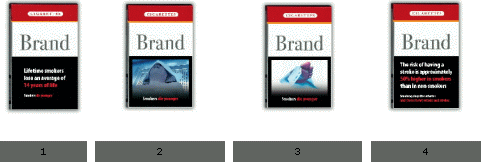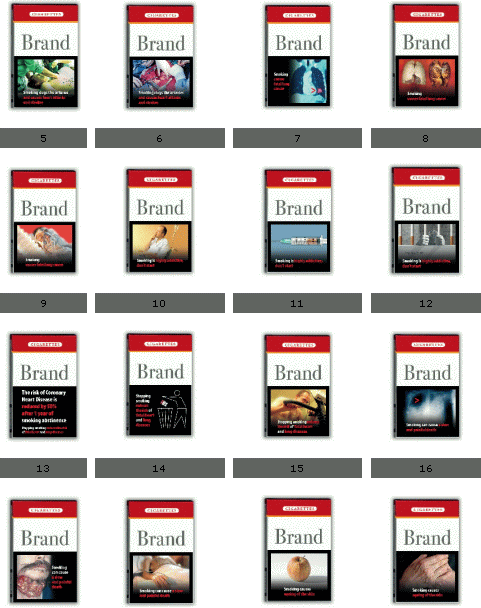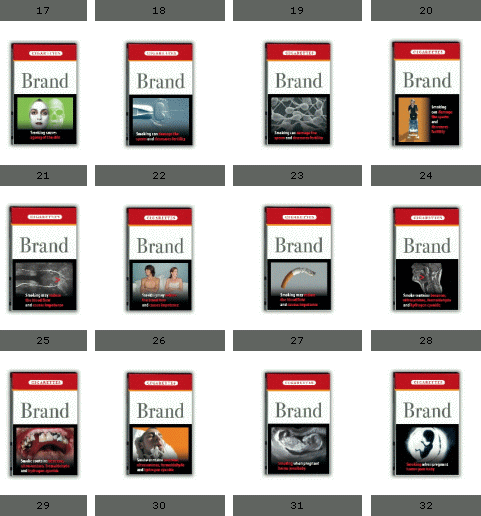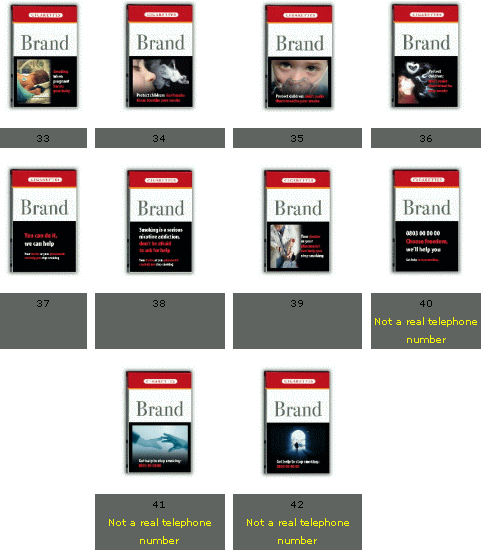ホーム > 政策について > 分野別の政策一覧 > 健康・医療 > 健康 > たばこと健康に関する情報ページ > たばこ対策関係省庁連絡会議 > 第1回たばこ対策関係省庁連絡会議 > 資料6−A
資料6−A
(http://europa.eu.int/comm/mediatheque/photo/select/tabac_en.htm)
 |
Health warnings on tobacco products The EU is intensifying its fight against tobacco. At a press conference in Brussels today -22/10/04- David Byrne, the European Commissioner for Health and Consumer Protection, unveiled new hard hitting picture warnings for cigarette packs. They form part of a database of 42 images designed for use in combination with the hard hitting health warnings introduced EU-wide in 2003. EU countries who so wish will be able to use the pictures to add impact to their health warnings. |




PDF:81KB
○イギリス 公衆衛生白書(2004年)
Public health White Paper
Smoking reductionSubject to further consultation and legislation, by the end of 2008 all enclosed public places and workplaces will be smoke-free except for those specially exempted. By 2006, all government departments and the National Health Service will be smoke-free, with limited exceptions.
For smokers, there will be better access to effective help, such as NHS stop smoking services.
SMOKE-FREE PUBLIC PLACES
69. Exposure to secondhand smoke is one topic where nationally and locally individuals and communities have already generated pressure for action to improve health choices. This is one of the most hotly debated issues, involving as it does a conflict between individual rights, and between rights and responsibilities in society.
70. Three-quarters of respondents in the Opinion Leader Research (OLR) survey agreed that the Government should prevent people from doing things that put the health of others at risk. People want to see a shift in the balance between the rights of the minority of people who choose to smoke and the rights of other people whose health or enjoyment may be adversely affected by secondhand smoke. They do not, however, believe that this requires a complete ban in all licensed premises.
71. The evidence of risk to health from exposure to secondhand smoke points towards an excess number of deaths, although debate on the precise scale of the impact continues. The consultation demonstrated clear concerns about both the health impact and discomfort felt by many in smoke-filled environments, with particular concerns about locations such as work places, where people may not have been able to choose to be in a smoke-free environment.
72. As the stark new warnings on cigarette packs say ‘Smoking seriously harms you and others around you’. Among the conditions linked to secondhand smoke are:
□ lung cancer;
□ heart disease;
□ asthma attacks; and
□ sudden infant death syndrome.
73. The best way that smokers can reduce the risk to themselves of those diseases that are caused by smoking is by giving up. That is why Chapters 5 and 6 put such emphasis on providing information and support to help individuals give up. But as a society we can act to help smokers to make that difficult healthy choice and stick to it. We know that one of the greatest benefits from smoke-free public places is that people trying to give up smoking can find it easier to succeed if social pressures not to smoke are increased.
74. There has already been significant response across society. Thirty years ago, 46% of people in England smoked. Today it is 26%. By 2003, some 50% of people said their workplace was completely smoke-free, and in total 88% of people said their workplace had some form of smoking restriction in place. But the evidence from the consultation and from public surveys is that this is not enough. Repeatedly, the message from the large majority of smokers as well as nonsmokers is that one of the ways to improve their local opportunities for health is through smoke-free settings.
75. Some workplaces are also primarily places where people come together to drink alcohol. Views about the case for smoking bans in pubs were different from views on workplaces as a whole. Surveys and opinion polls consistently show some 86% of people in favour of workplace restrictions, and a similarly substantial majority of people supporting restrictions in restaurants. But when people are asked whether smoking should be restricted in pubs the figures fall substantially - to around 56% - and when people are asked which sort of restrictions they would prefer in pubs only 20% of people choose ‘no smoking allowed anywhere’ and the majority tend to be opposed to a complete ban.
76. Nevertheless, this is an area where people cannot readily secure change for themselves. In our 1998 White Paper Smoking Kills we were clear that fast and substantial progress was needed: we decided that the case for legal action to restrict smoking was not, at that time, sufficiently strong. However, change has been slow and public demand for action has increased. It is one of the few instances in this White Paper where we believe the right response is Government action in the form of legislation.
We therefore intend to shift the balance significantly in favour of smoke-free environments. Subject to parliamentary timetables, we propose to regulate, with legislation where necessary, in order to ensure that:
| □ all enclosed public places and workplaces (other than licensed premises which are dealt with below) will be smoke-free; □ licensed premises will be treated as follows:
|
77. We intend to introduce smoke-free places through a staged approach:
| □ by the end of 2006, all government departments and the NHS will be smoke-free; □ by the end of 2007, all enclosed public places and workplaces, other than licensed premises (and those specifically exempted), will, subject to legislation, be smoke-free; □ by the end of 2008 arrangements for licensed premises will be in place. |
We will use the intervening period of time to consult widely in the process of drawing up the detailed legislation, including on the special arrangements needed for regulating smoking in certain establishments - such as hospices, prisons and long stay residential care. In implementing this policy there are also a range of practical issues that will need to be addressed - we will need to consult, for example, with schools and other institutions on how best to give practical effect to this policy, as well as how best to enforce the policy and what penalties will be appropriate for people who do not follow the law.
Some have pointed to a risk inherent in this proposal that pubs may decide to stop serving food instead of imposing a smoking ban; and that this may have an adverse impact on our drive to tackle binge-drinking. We believe that the profitability of providing food will be sufficient to outweigh any perverse incentive for pub owners to choose to switch. However, we will consult widely with all those engaged in combating irresponsible drinking to ensure the risk is mitigated, and will monitor outcomes.
78. We believe these measures respond to what we have heard, striking the right balance between responsibilities and freedoms. They will represent a major advance, making smoke-free public places the norm.
79. Based on the current makeup of pubs we estimate that 10 to 30% might fall into the category of ‘do not prepare food’ - meaning around 10 to 30% of pubs could be smoking, and the remainder smokefree.
CONCLUSION
80.We have learnt much over the past few years about how new forms of community action and leadership can make a real difference to people’s lives. These examples have demonstrated how people together can achieve more than individuals alone. We need to unleash this potential for health, starting with the roll out of models driven by communities for health. Government will act to hasten progress towards a smoke-free public environment and - in partnership with others -- to increase opportunities for activity. The public sector, led by local authorities with PCTs, will need to play its part. Independent sector organisations, nationally and locally, are already demonstrating their commitment.
(http://www.dh.gov.uk/assetRoot/04/09/47/60/04094760.pdf)
○ブータン 政府系広報誌kuensel紙(2004年12月17日)
Tobacco sale banned
Posted on Friday, December 17 @ 21:04:16 CST BST
→ 17 December 2004 - In keeping with the decision of the Bhutanese parliament, the nationwide ban on the sale of tobacco products was implemented from today making Bhutan the first country in the world to do so.
 Thimphu, symbolically marking the first day of the ban |
People, however, can import cigarettes for personal consumption but subject to certain restrictions.
According to the Revenue and Customs, the maximum amount of cigarettes that can be imported for personal consumption is 200 pieces. For other tobacco products like snuff and chewing tobacco, the maximum import amount is 50 grams. For pipe tobacco, it is three tins of 50 grams each.Cigarettes imported from India will be levied a 100 percent sales tax on the cost price whereas imports from third countries will be levied a 100 percent sales tax plus a 100 percent customs duty. Prior to the ban, cigarettes were levied a 50 percent sales tax.
The tax is less on the import from India because of the free trade agreement that Bhutan shares with the country, said custom officials adding that cigarette was the most sold tobacco product in Bhutan.
The revenue and customs has also stopped, from December 17, the duty free quota of one cigarette carton of third country brand for all Druk Air passengers.The sale of tobacco products in the country’s only duty free shops in Thimphu and Paro Airport was banned from January 2003.
But people are skeptic that the ban would lead to a black market. In 18 of the 20 districts where an existing tobacco sales ban is in force, tobacco is discreetly available at inflated prices.However, ministry officials warned that it would impose Nu. 10,000 on the ban violators and owners of shops and hotels engaged in tobacco sales would lose their business licenses.
Different stakeholders are involved in the implementation of the ban with the Ministry of Trade and Industry taking the lead.Stricter rules are also being proposed to snuff out the smoke. The Health Ministry during the first coordination meeting of stakeholders on tobacco control on December 15, proposed banning smoking in several public places including recreational outlets like bars, discotheques, restaurants and snooker rooms.
Smoke free places are also being proposed for sports centres like archery grounds, public institutions, commercial outlets and bus stands. The meeting also discussed the need of having an “enabling legislation” to help implement the ban.
To make the ban effective, the Health Ministry has indicated that the issue of the sale of cigarettes from DANTAK and IMTRAT canteens around the country will be taken up with the government soon. People have criticised that the ban on sale of tobacco would be toothless as long as the DANTAK and IMTRAT canteens were allowed to sell cigarettes to the Bhutanese.Revenue and customs officials say that the impact of the ban of tobacco products on the country’s revenue will be “negligible”. Although heavily and widely sold in the market, total import figures in 2002 from India showed, in the words of one custom official, a ridiculous amount of Nu.37,000, half of which went to the government’s revenue.
Import figure for other tobacco products like chewing tobacco, for the same year, was Nu. 10,000. In 2003, the total import of tobacco products from India was worth Nu. 200,000.“Cigarette was one of the main business items which was smuggled in bulk into the country,” said customs official Sangay Wangdi. He said that businessmen rarely declared tobacco products at the checkpoints and some of them reaped maximum profits from the illegal sale of the tobacco products. Most of the declarations were made only after seizure of the goods, he added.
However, third country import of cigarettes in 2002 - Hongkong and Singapore together- was worth Nu. 5.0 million, and in 2003 it was worth Nu. 2.0 million.Although a popular decision in the country, smokers deeply resent the ban. Many hardcore smokers have stacked up their cupboards with several cartons of cigarettes to ride the ban for some time.
“The ban is ridiculous and is an infringement on personal rights to smoke or not,” said Dorji who, at 27, puffs his way through 35 sticks of cigarettes a day.Meanwhile ban implementors say that the ban would be “effectively implemented” this time.
By Kencho Wangdi
kencho@kuensel.com.bt
(http://www.kuenselonline.com/article.php?sid=4822)
○イタリア 2005年1月10日禁煙法施行
|
ホーム > 政策について > 分野別の政策一覧 > 健康・医療 > 健康 > たばこと健康に関する情報ページ > たばこ対策関係省庁連絡会議 > 第1回たばこ対策関係省庁連絡会議 > 資料6−A


